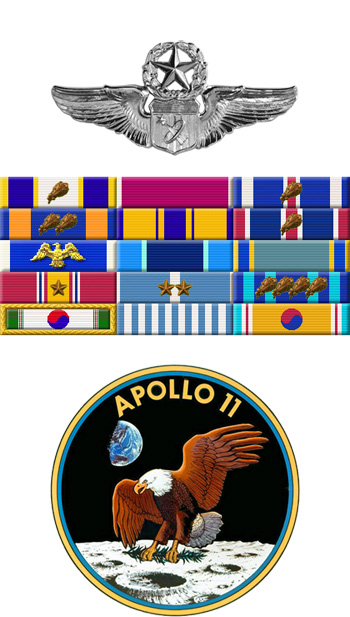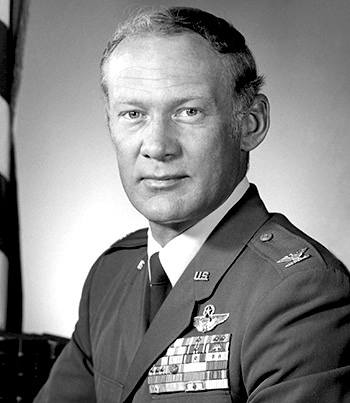
|
Buzz Aldrin |
 |
|||
| Rank, Service | ||||
Colonel O-6, U.S. Air Force |
||||
| Veteran of: | ||||
|
||||
| Tribute: | ||||
Edwin E. Aldrin, Jr. (later legally changed to Buzz Aldrin), was born on January 20, 1930, in Glen Ridge, New Jersey. He entered the U.S. Military Academy at West Point on July 1, 1947, and graduated 3rd in his class with a commission as a 2d Lt in the U.S. Air Force on June 5, 1951, with a date of rank in the Air Force of June 1, 1951. Lt Aldrin completed pilot training and was awarded his pilot wings at Bryan AFB, Texas, in August 1952, and then completed F-86 Sabre Combat Crew Training before serving as an F-86 pilot with the 16th Fighter Interceptor Squadron of the 51st Fighter Interceptor Group in Korea from December 1952 to May 1953. During this time he was credited with the destruction of 2 enemy aircraft in aerial combat, plus 1 more damaged in the air. His next assignment was as Assistant Operations Officer with the 51st Fighter Interceptor Group in Korea from May to December 1953, followed by jet instructor training from January to August 1954. He served as a fighter weapons instructor pilot with the 3599th Combat Crew Training Squadron at Nellis AFB, Nevada, from August 1954 to April 1955, and then as Aide to the Dean of Faculty at the U.S. Air Force Academy from April 1955 to August 1956. Capt Aldrin's next assignment was as an F-100 Super Sabre pilot with the 22nd Fighter Day Squadron (later redesignated 22nd Tactical Fighter Squadron) at Bitburg AB, West Germany, from August 1956 to May 1959, followed by an Air Force Institute of Technology assignment to complete his PhD in Astronautics at the Massachusetts Institute of Technology from July 1959 to February 1963. After serving with the Project Gemini Target Office of the Air Force Space Systems Division in Los Angeles, California, Maj Aldrin was selected as one of the 3rd group of astronauts by NASA in October 1963. His first space flight was aboard Gemini XII, the 10th and final manned Gemini flight, from November 11-15, 1966. Col Aldrin then served as lunar module pilot for Apollo 11, the first mission to touch down on the moon, from July 16-24, 1969. During this mission, he became the 2nd person to walk on the lunar surface on July 20, 1969. He resigned from NASA in July 1971, and then served as Commandant of the Aerospace Research Pilot School at Edwards AFB, California, from July 1971 until his retirement from the Air Force on March 1, 1972. |
||||
|
||||

